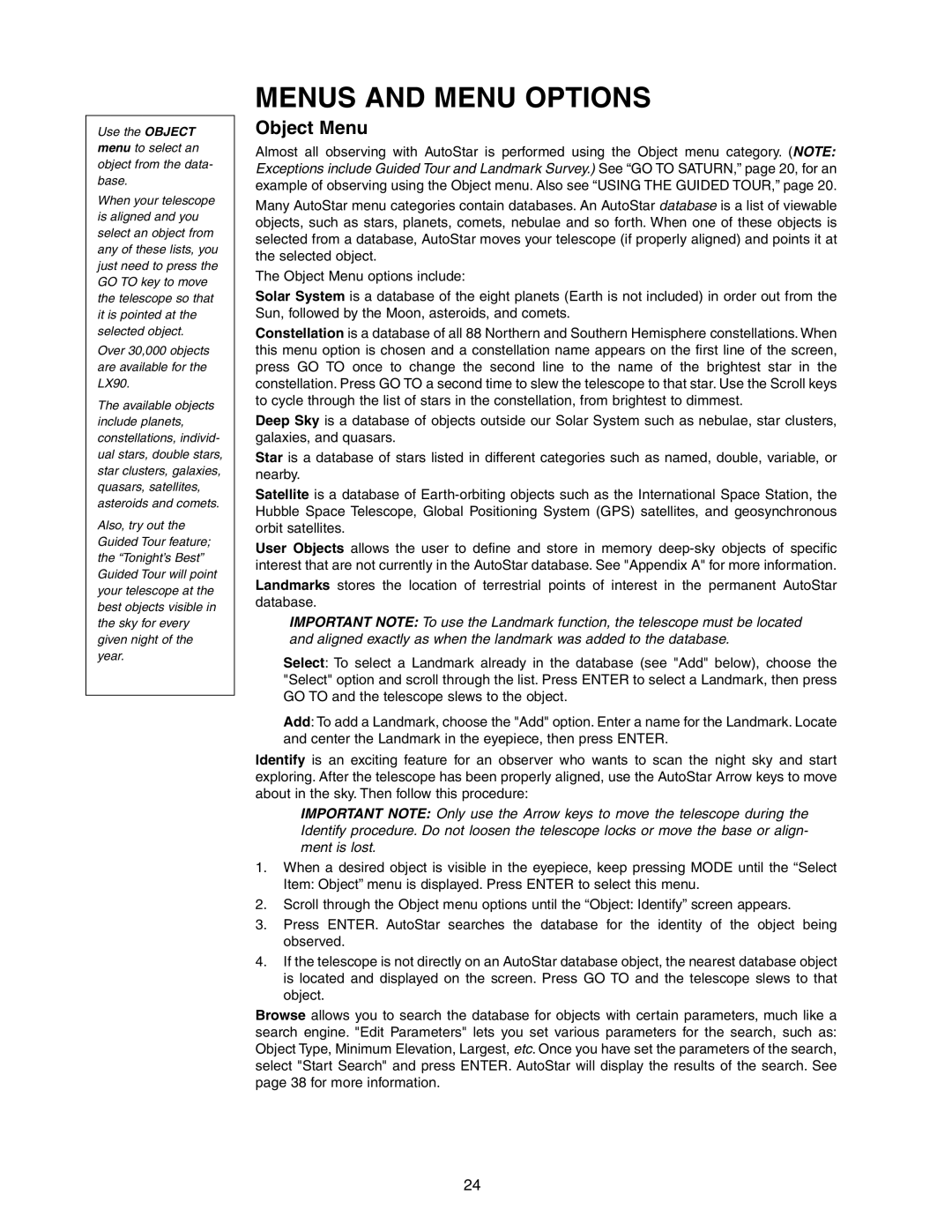
Use the OBJECT menu to select an object from the data- base.
When your telescope is aligned and you select an object from any of these lists, you just need to press the GO TO key to move the telescope so that it is pointed at the selected object.
Over 30,000 objects are available for the LX90.
The available objects include planets, constellations, individ- ual stars, double stars, star clusters, galaxies, quasars, satellites, asteroids and comets.
Also, try out the Guided Tour feature; the “Tonight’s Best” Guided Tour will point your telescope at the best objects visible in the sky for every given night of the year.
MENUS AND MENU OPTIONS
Object Menu
Almost all observing with AutoStar is performed using the Object menu category. (NOTE: Exceptions include Guided Tour and Landmark Survey.) See “GO TO SATURN,” page 20, for an example of observing using the Object menu. Also see “USING THE GUIDED TOUR,” page 20.
Many AutoStar menu categories contain databases. An AutoStar database is a list of viewable objects, such as stars, planets, comets, nebulae and so forth. When one of these objects is selected from a database, AutoStar moves your telescope (if properly aligned) and points it at the selected object.
The Object Menu options include:
Solar System is a database of the eight planets (Earth is not included) in order out from the Sun, followed by the Moon, asteroids, and comets.
Constellation is a database of all 88 Northern and Southern Hemisphere constellations. When this menu option is chosen and a constellation name appears on the first line of the screen, press GO TO once to change the second line to the name of the brightest star in the constellation. Press GO TO a second time to slew the telescope to that star. Use the Scroll keys to cycle through the list of stars in the constellation, from brightest to dimmest.
Deep Sky is a database of objects outside our Solar System such as nebulae, star clusters, galaxies, and quasars.
Star is a database of stars listed in different categories such as named, double, variable, or nearby.
Satellite is a database of
User Objects allows the user to define and store in memory
IMPORTANT NOTE: To use the Landmark function, the telescope must be located and aligned exactly as when the landmark was added to the database.
JSelect: To select a Landmark already in the database (see "Add" below), choose the "Select" option and scroll through the list. Press ENTER to select a Landmark, then press GO TO and the telescope slews to the object.
JAdd: To add a Landmark, choose the "Add" option. Enter a name for the Landmark. Locate and center the Landmark in the eyepiece, then press ENTER.
Identify is an exciting feature for an observer who wants to scan the night sky and start exploring. After the telescope has been properly aligned, use the AutoStar Arrow keys to move about in the sky. Then follow this procedure:
IMPORTANT NOTE: Only use the Arrow keys to move the telescope during the Identify procedure. Do not loosen the telescope locks or move the base or align- ment is lost.
1.When a desired object is visible in the eyepiece, keep pressing MODE until the “Select Item: Object” menu is displayed. Press ENTER to select this menu.
2.Scroll through the Object menu options until the “Object: Identify” screen appears.
3.Press ENTER. AutoStar searches the database for the identity of the object being observed.
4.If the telescope is not directly on an AutoStar database object, the nearest database object is located and displayed on the screen. Press GO TO and the telescope slews to that object.
Browse allows you to search the database for objects with certain parameters, much like a search engine. "Edit Parameters" lets you set various parameters for the search, such as: Object Type, Minimum Elevation, Largest, etc. Once you have set the parameters of the search, select "Start Search" and press ENTER. AutoStar will display the results of the search. See page 38 for more information.
24
